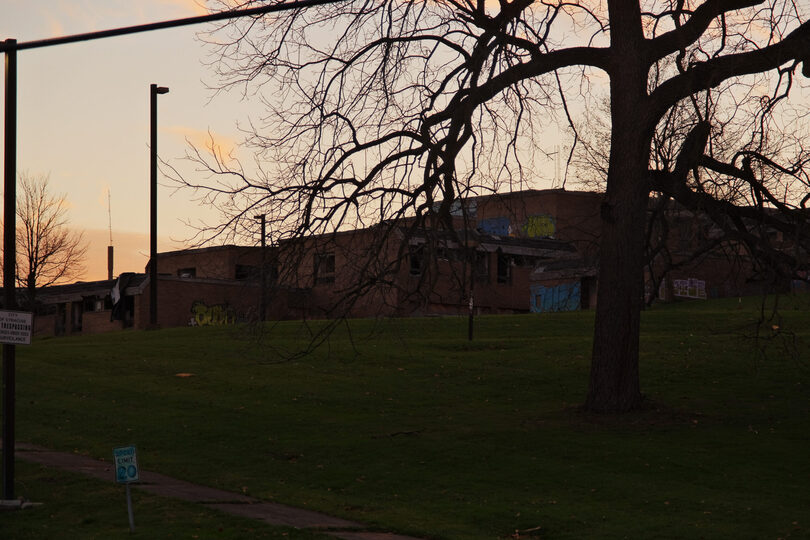Syracuse to revitalize abandoned properties for affordable housing

The City of Syracuse will convert the former Syracuse Developmental Center into about 500 units of affordable housing. The Syracuse Common Council approved the demolition of the center at its meeting in March. Maxine Brackbill | Photo Editor
Support The Daily Orange this holiday season! The money raised between now and the end of the year will go directly toward aiding our students. Donate today.
Amid a continued housing crisis, the City of Syracuse is working on several construction projects to build affordable housing for the community, including a 50-acre property of the former Syracuse Developmental Center.
The city will convert the Westside property at 800 S. Wilbur Ave. into around 500 units of affordable housing. The Syracuse Common Council initially approved the demolition of the vacant center at its meeting on March 27 and shared additional details on Oct. 30.
The Syracuse Developmental Center has occupied the property since the 1850s, and the current structure dates back to the 1970s, said Robert Searing, curator of history at the Onondaga Historical Association. The center closed in 1998 and has since been abandoned.
The building, which is currently covered in graffiti and has boarded-up windows, is in a poor state, Searing said.
“I know it’s been in the news here locally for many years and had become a site for vandalism, for drug use,” Searing said. “It’s been a blight for the neighborhood for quite a long time.”
Patrick Hogan, the District 2 Common Councilor, said bidding for the demolition of the current structure will open soon. To go ahead with the current plans of turning the property into three large buildings of multiple units, the building has to come down, Hogan said.
Hogan said two of the new buildings will be affordable housing and one will be market-rate housing.
Hogan expressed the importance of building a variety of different housing options in the community, including low-income, workforce and market-rate housing.
“Obviously there is a great need in affordable housing, but also as far as the community goes, we need market-rate housing too in order to support all the services that we need to run a city,” Hogan said.
Hogan also said the city’s projects are mostly dependent on the national Low-Income Housing Tax Credit program, which includes specific income qualifications. To qualify for an LIHTC average income set-aside, at least 40% of a project’s units must be either rent-restricted or low-income units, according to guidance by the New York State Division of Housing and Community Renewal.
Additionally, the average imputed income of the units in a project cannot exceed 60% of the area’s median income, according to the guidance. The City of Syracuse had a median household income of $40,490, according to 2021 data from the U.S. Census Bureau.
The Syracuse Common Council also approved the use of American Rescue Plan Act funds in April to renovate the former B & B Lounge at 310-312 South Ave. in the South Side neighborhood. Progress on the site has been “very slow,” said Karen Schroeder, chief communications officer for Home HeadQuarters Inc., the nonprofit housing and community development organization overseeing the construction.
Beyond ARPA, the project is funded by the Empire State Development Downtown Revitalization Initiative. Schroeder said the variety of funding sources has slowed down progress, and contracts for part of the funding were just finalized. Home HeadQuarters expects work to start immediately, Schroeder said.
The former lounge property will be a mixed-use development, with two affordable apartments sitting above a restaurant. Before the organization took over the property, parts of the building were deemed unsafe, Schroeder said.
For the restaurant downstairs, Schroeder said the organization has been in talks with Seafood Haven, a fresh fish fry restaurant. In terms of timeline, she hopes to see “something concrete” within a year.
“We’ve been in conversation with a contractor for some time now, so we are anxious to get started,” Schroeder said. “Whatever kind of progress we can make over the winter, we plan to do it.”
In addition to these two developments, both Hogan and Schroeder said various other affordable housing projects are in progress. The issues the city is facing with affordable housing, Hogan said, come from the funding streams used to finance these projects.
Hogan said the Common Council discussed how “unfortunate” it is that there is not a more flexible way than LIHTC to finance projects at its meeting Monday.
“Not only is there not enough money, there isn’t another option if we wanted to build for the viability of the city neighborhoods,” he said.
The issue of affordable housing is not a new one, however, Searing said, citing the 1935 creation of the Syracuse Housing Authority. He said Pioneer Homes, a complex in the South Side neighborhood, is the second oldest public housing project in the U.S.
“Syracuse was actually one of the first cities to get moving on (public housing),” he said.
Searing said the city has taken major strides every decade since SHA’s creation to increase the availability of affordable housing and has dealt with a “constant struggle” to meet increasing demand.
“It’s clear that there has always been a demand that far outstrips the supply,” Searing said. “So that’s been a challenge obviously for the municipality, and it’s been a challenge for the citizens of the city that are looking for affordable housing.”
Hogan, Schroeder and Searing all agreed that the impending arrival of Micron Technology in Clay will only further exacerbate the existing crisis.
Hogan called the current shortage of housing in the city a “huge issue” the city struggles with daily. Resolving this will take time, and it will be critical to work with the community, Hogan said.
“We have an affordable affordability crisis, and we have a market-rate crisis,” Hogan said. “That’s what we’re going to be grasping with, and there’s going to be some tough political choices that’ll have to be made.”





